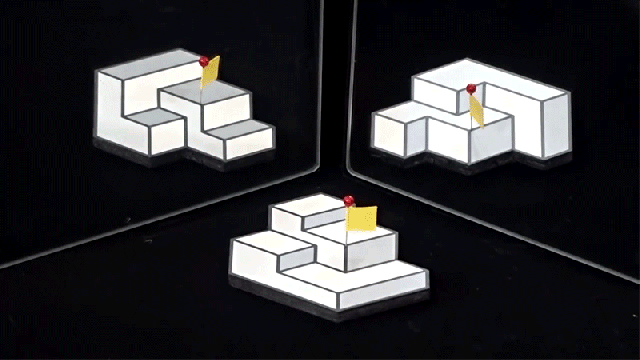Every year, various members of the illusion community — which is made up of scientists, neurologists, researchers, and even artists — get together to decide which of their recently created mind-melters deserves the honour of Best Illusion of the Year. This year, Japan’s Kokichi Sugihara claimed the top prize with a deceptively simple illusion that plays with how our mind perceives 3D objects.
This isn’t the first time Kokichi Sugihara, a mathematician at Meiji University in Japan, has won the Best Illusion of the Year honour. Nor is it the first time his fantastic illusions have shown up on Gizmodo. Triply Ambiguous Object, his latest award-winning creation, appears to be a simple 3D structure, with a tiny flag mounted on one of its many corners.
But when viewed from other perspectives, as this video demonstrates using a pair of mirrors, the object appears to be a completely different structure altogether, with the flag somehow simultaneously appearing in other locations. A clever use of shading, and how the 2D image has been illustrated, tricks the brain into thinking it exists in 3D.
As the viewer’s perspective changes when looking at the object from different low angles, which makes its lines appear slanted, the brain interprets those visual cues differently, producing three alternate 3D layouts for the object’s various platforms and protrusions.
Second place went to David Phillips, Priscilla Heard, and Christopher Tyler from the United Kingdom for their animation: Movement Illusion with a Twist.
It starts with a perpetual pattern of diamonds that appears to flow obliquely through the frame (up and to the right), but when a moving background pattern is introduced, giving your brain an additional reference point, the diamond pattern then appears to drift from the left to the right side of the frame, when in reality the animated pattern’s movements remain static.
Third place was awarded to Michael Pickard and Gurpreet Singh, also from the United Kingdom, for their Worm’s Eye View Illusion. A simple four-frame repeating animation that changes the colour of a worm’s stripes appears to move in a very specific direction.
But when the colours change, as does their relative brightness as perceived by the brain, the movement suddenly appears to reverse direction.
Conclusion? Your brain is lying to you and you should probably just go find a nice, quiet, dark cave to live out the rest of your life.
